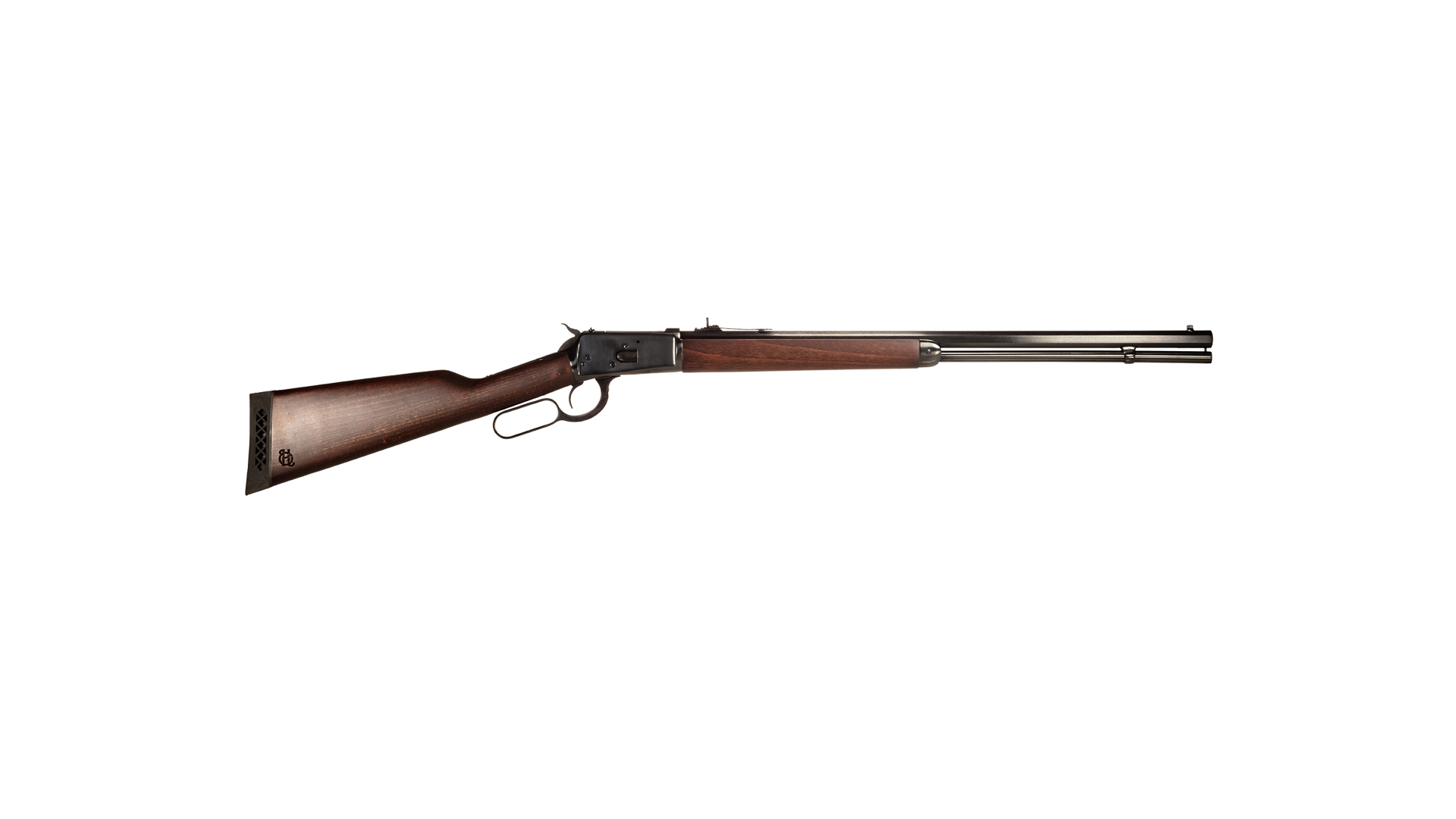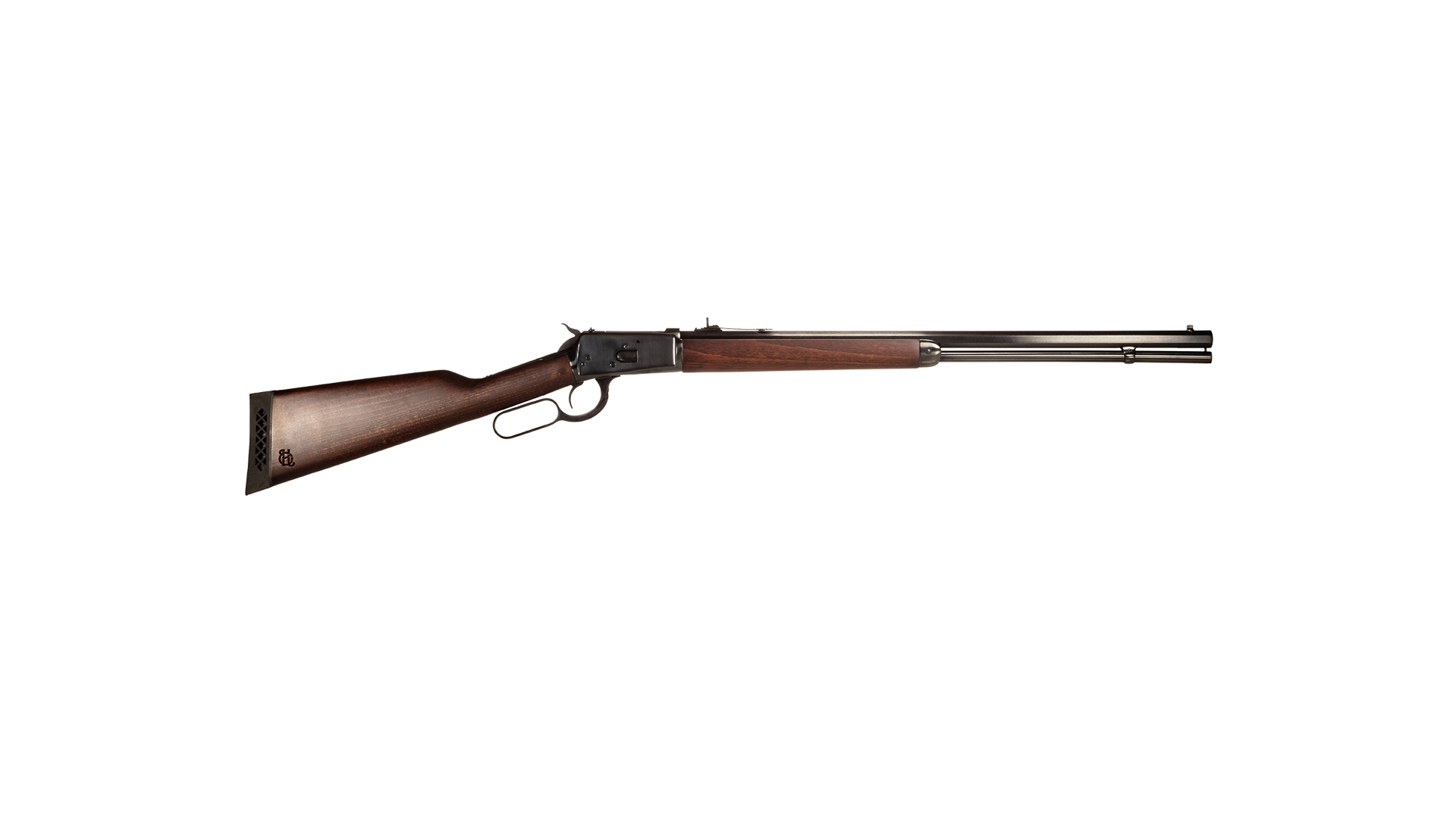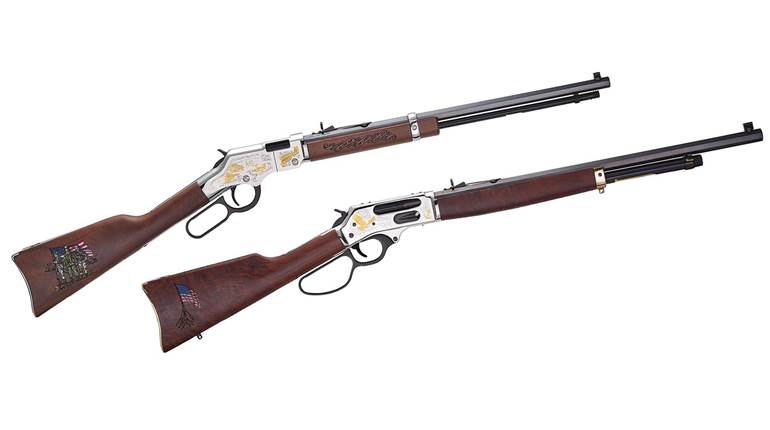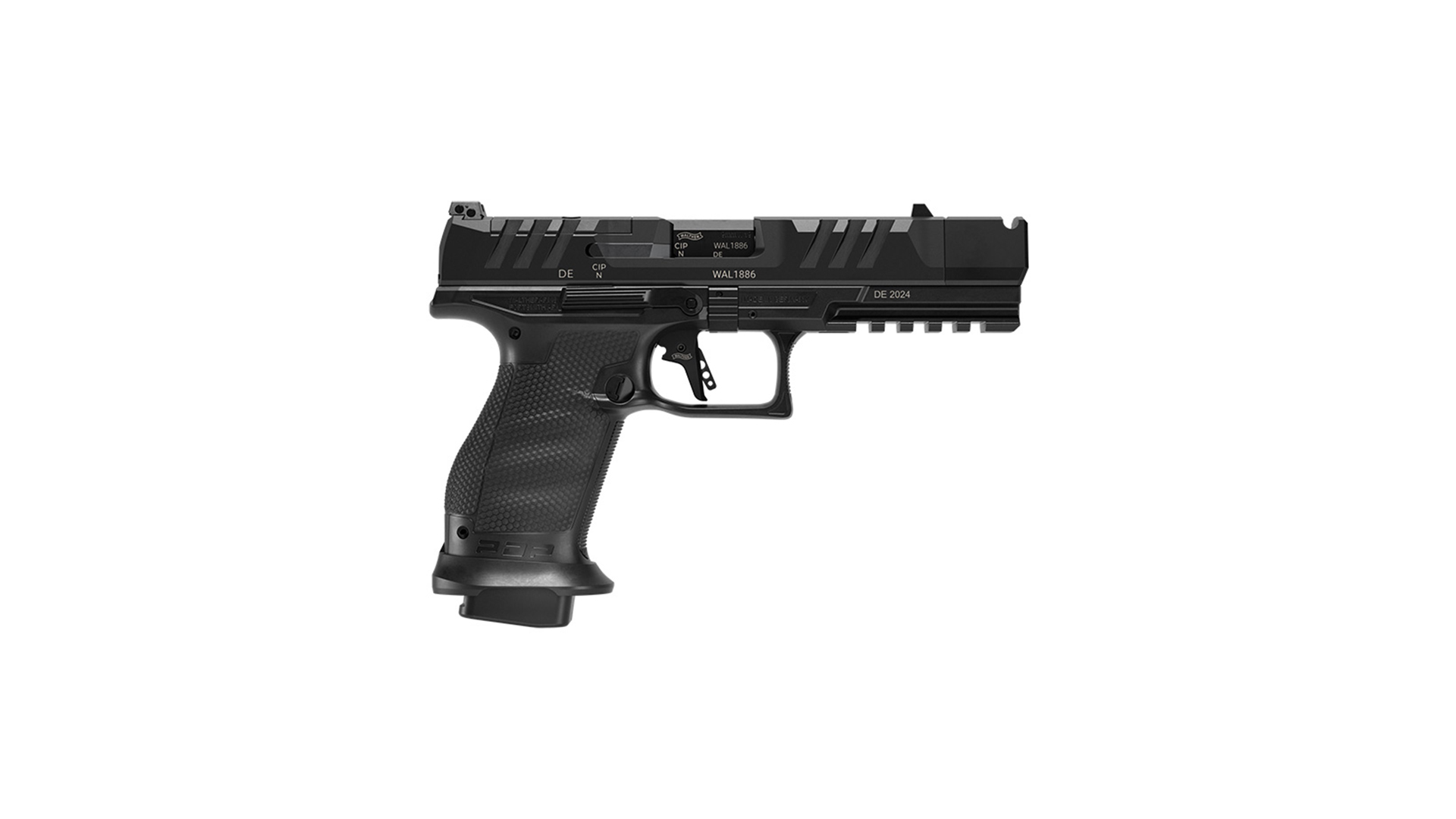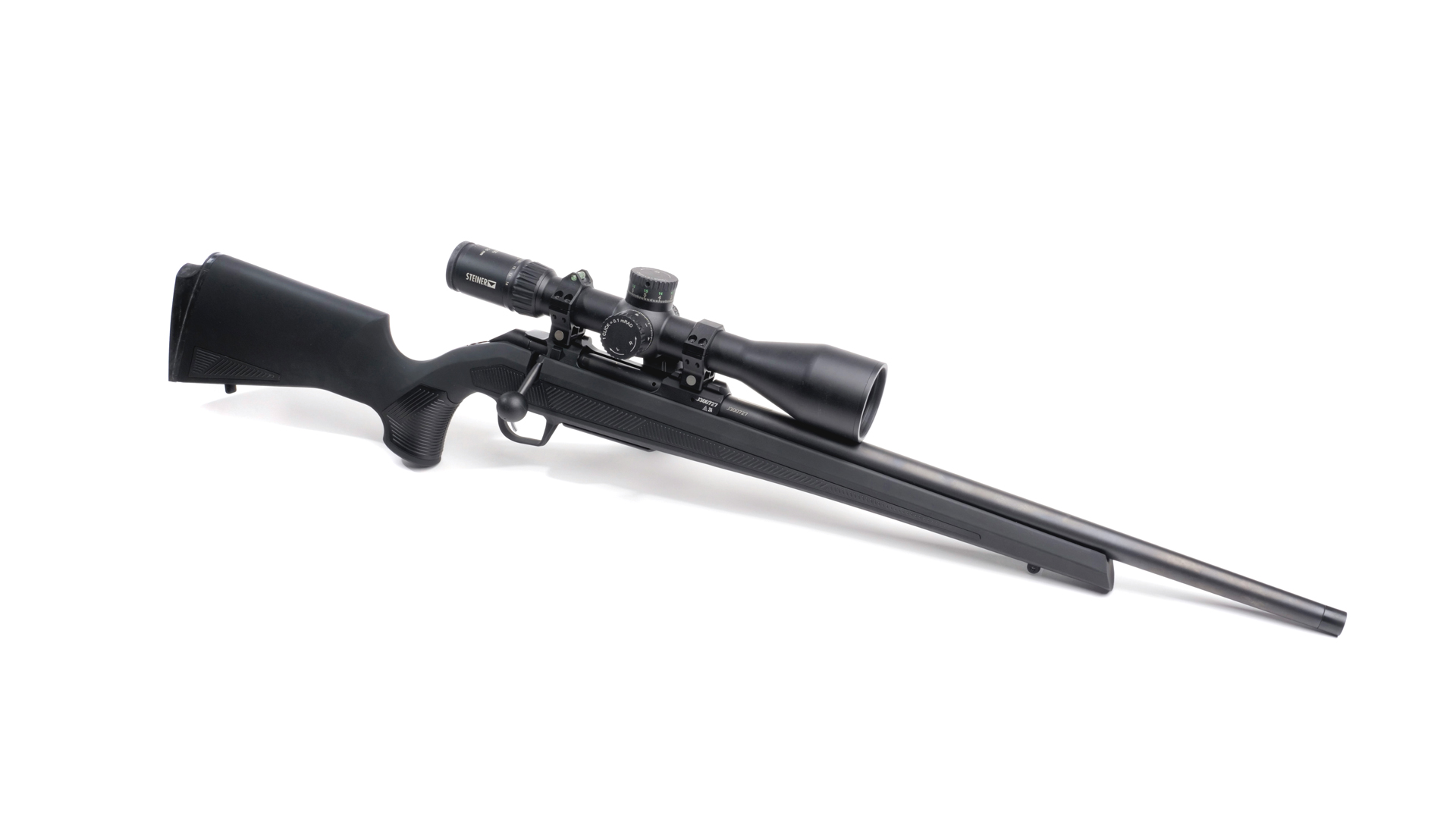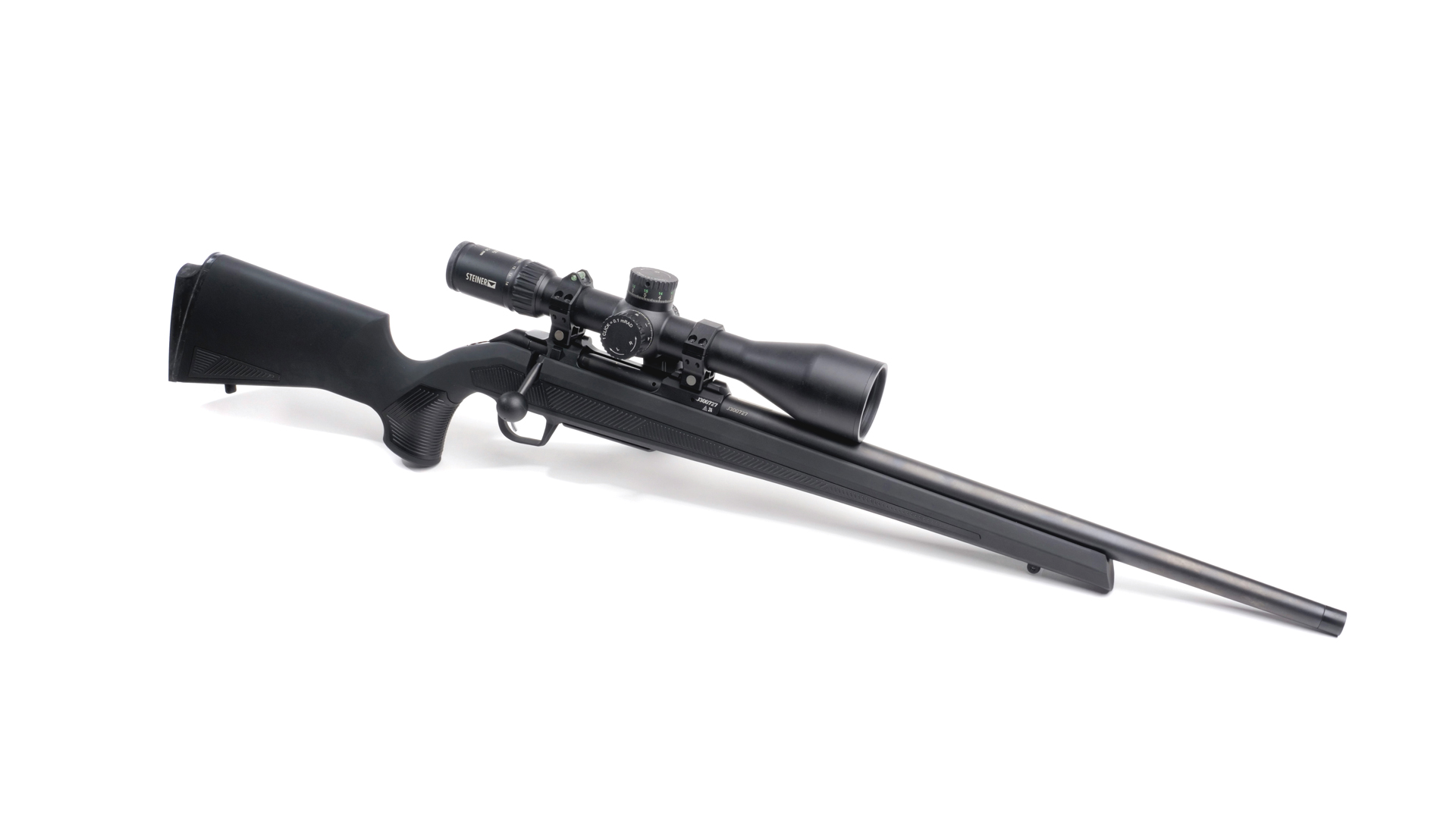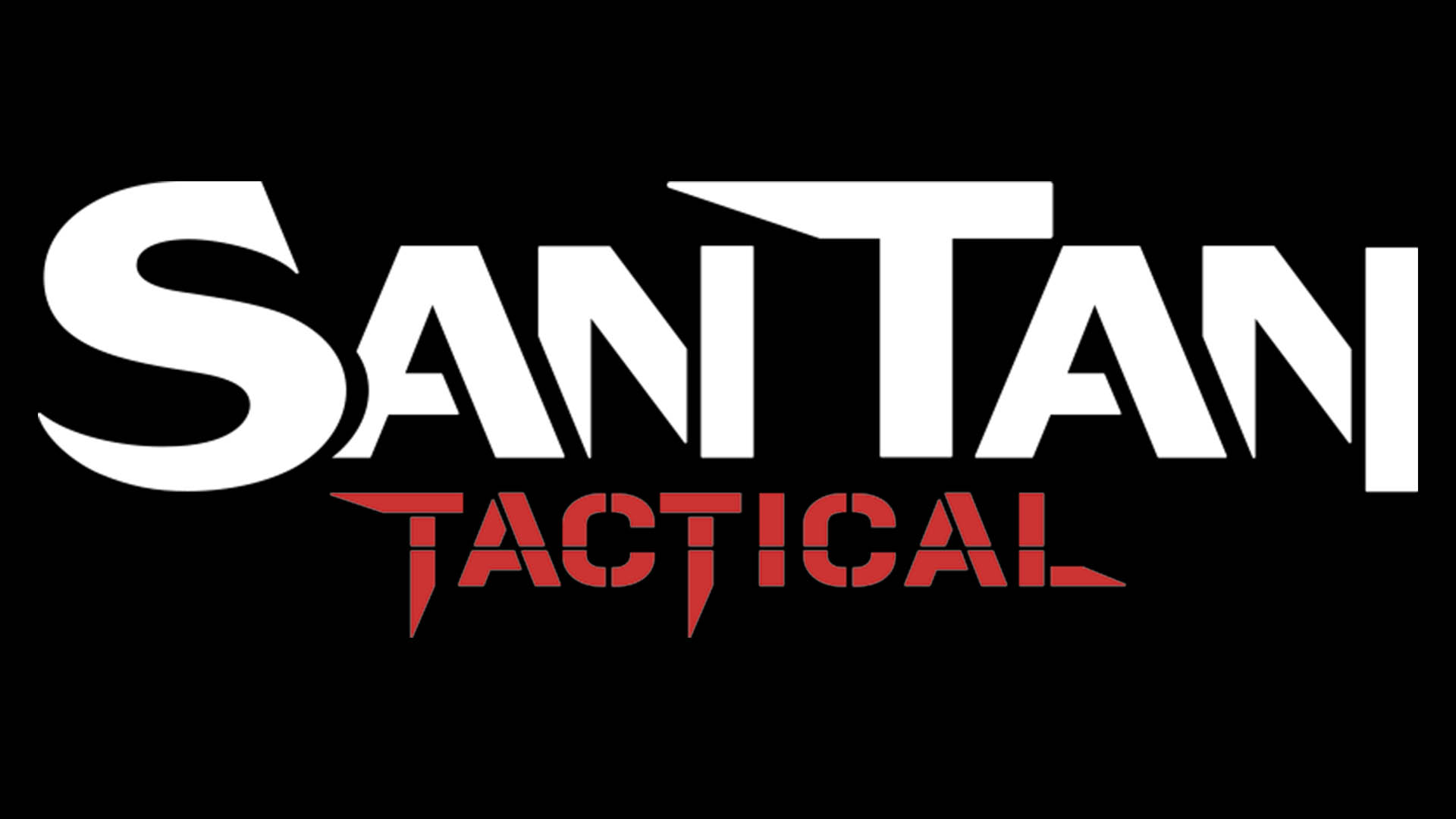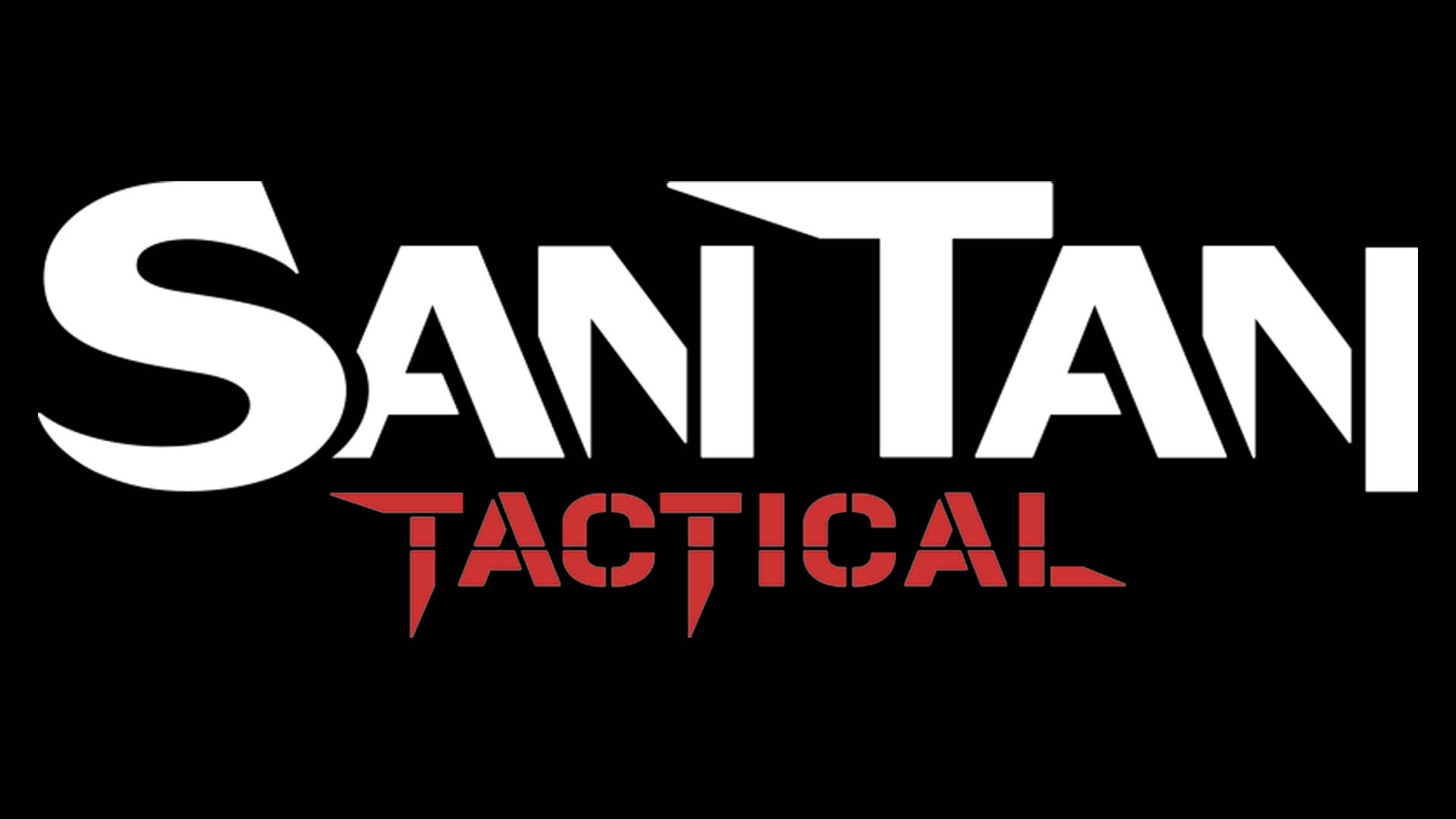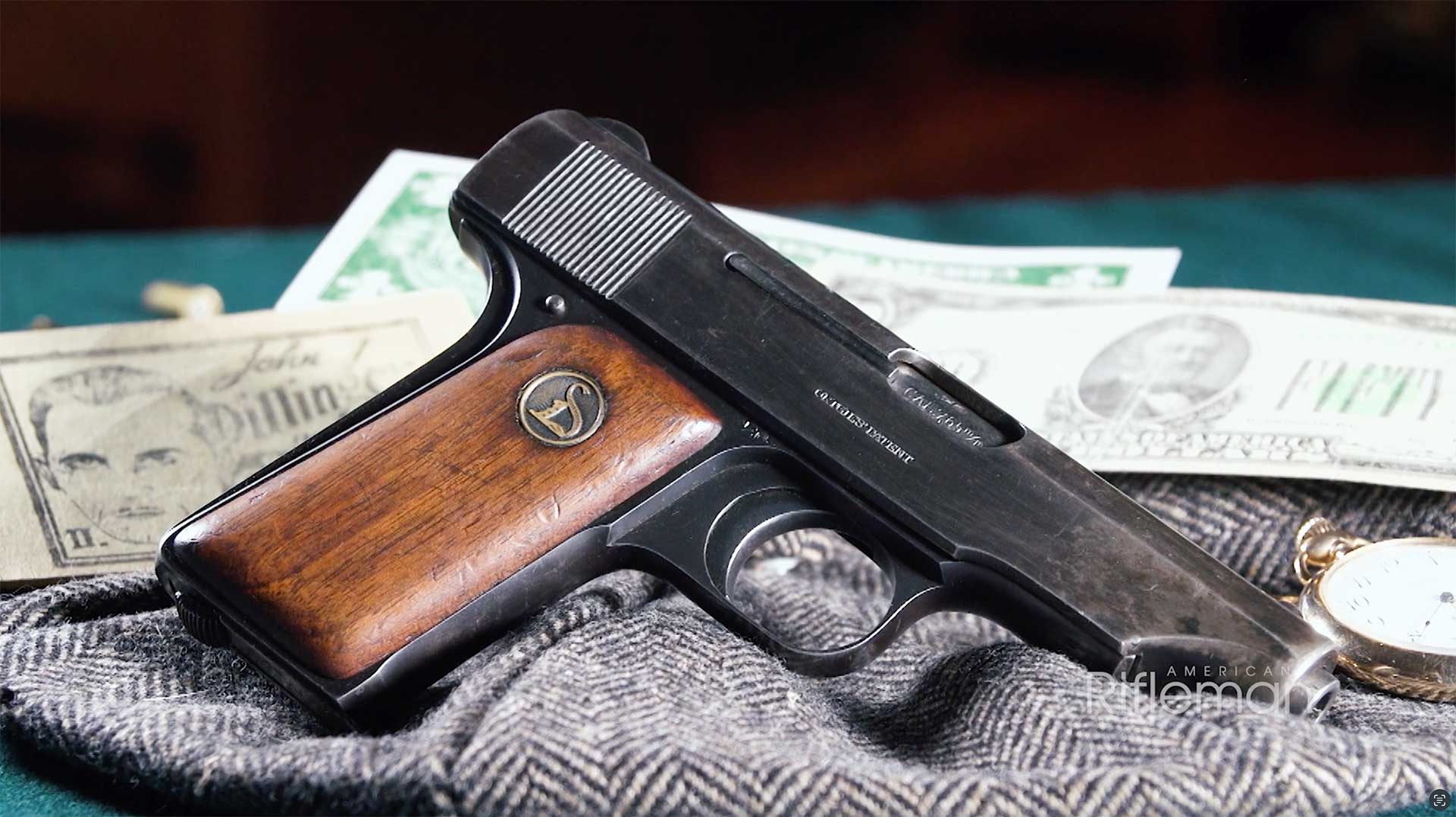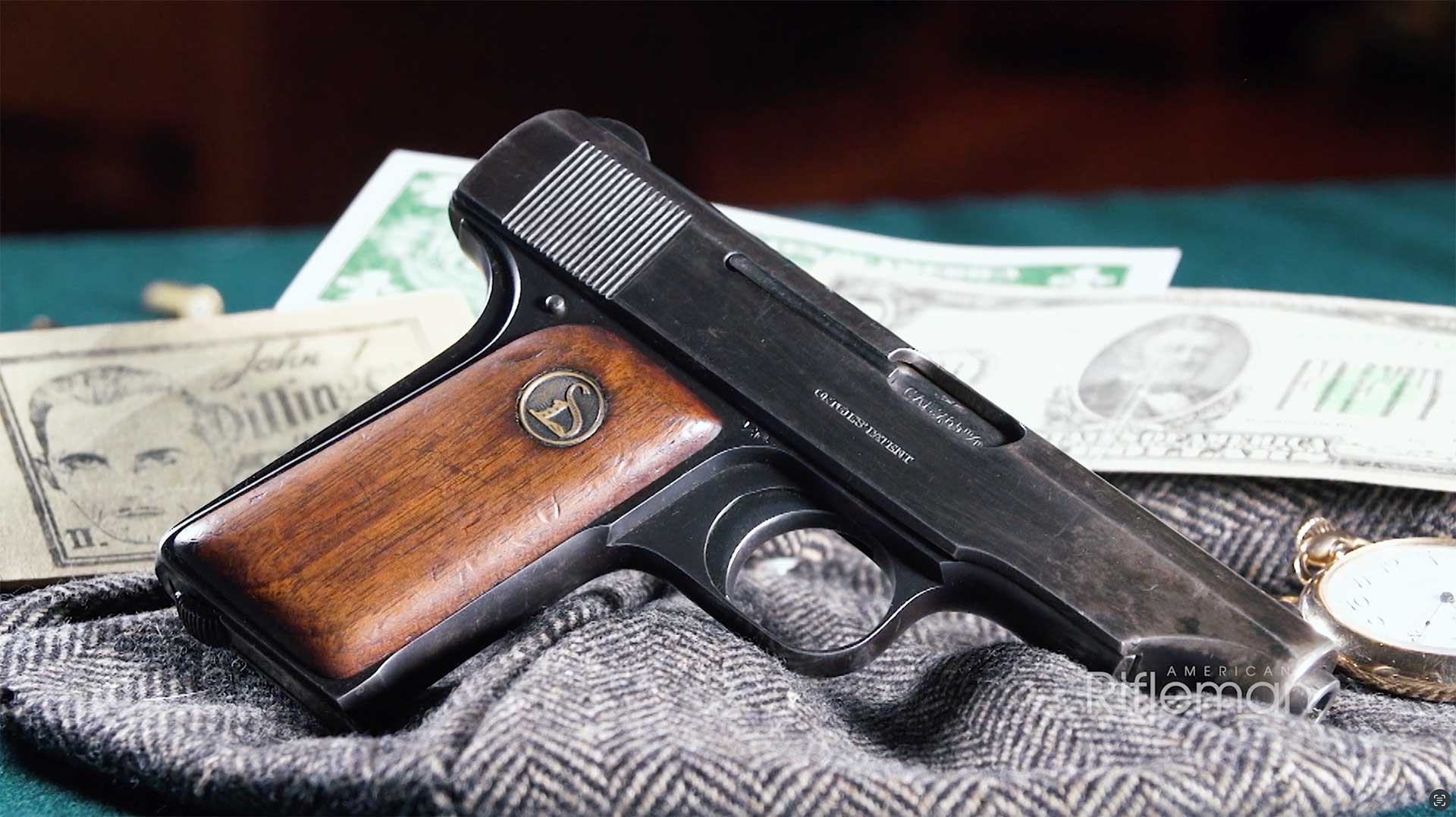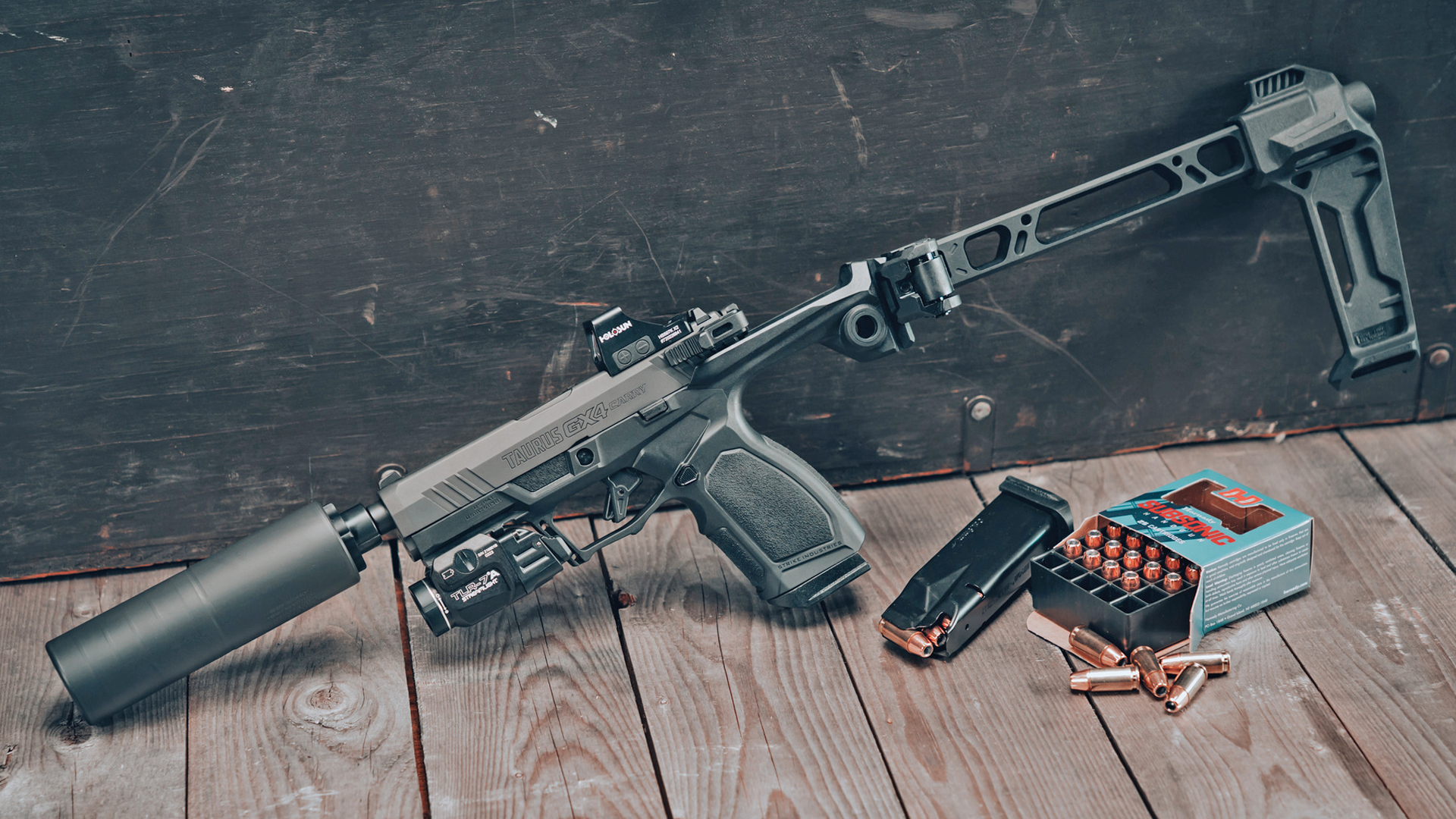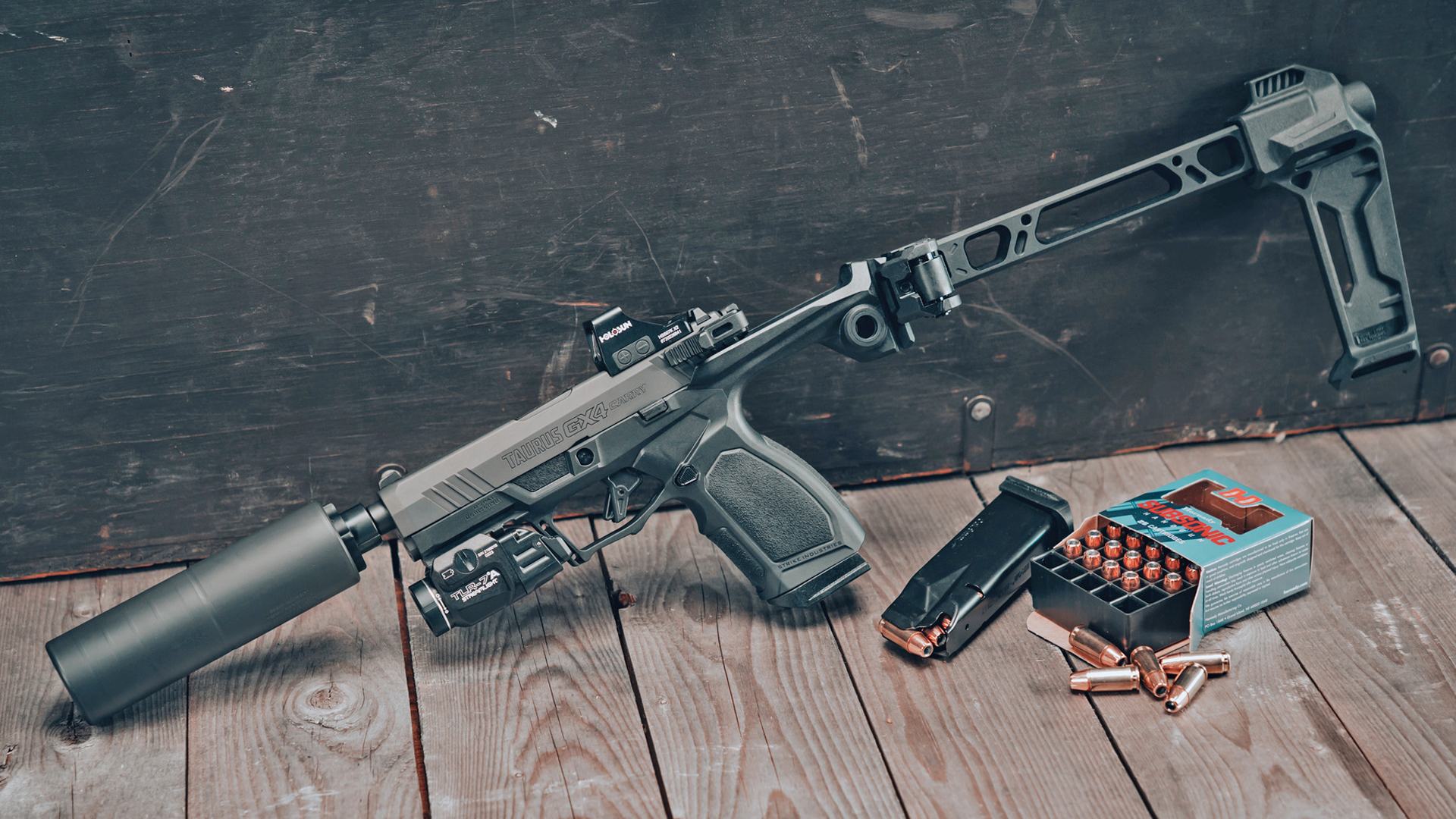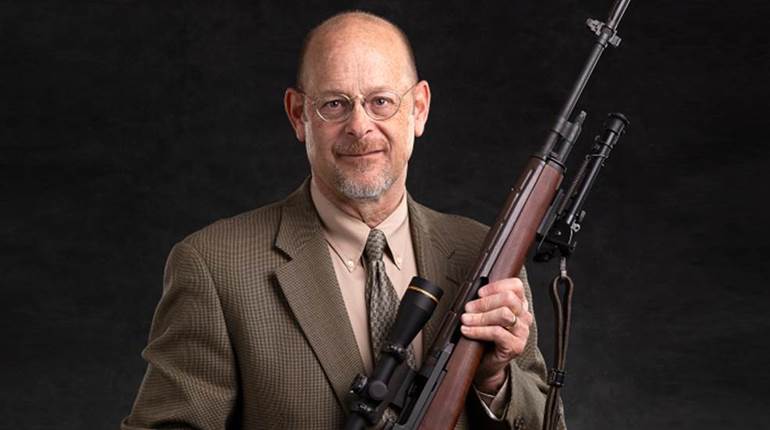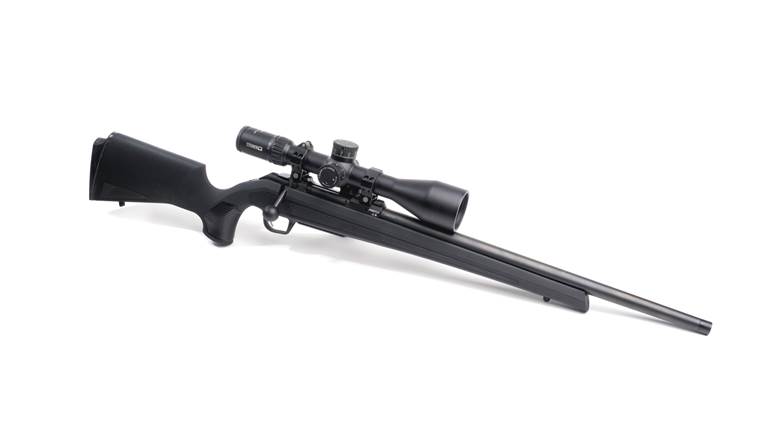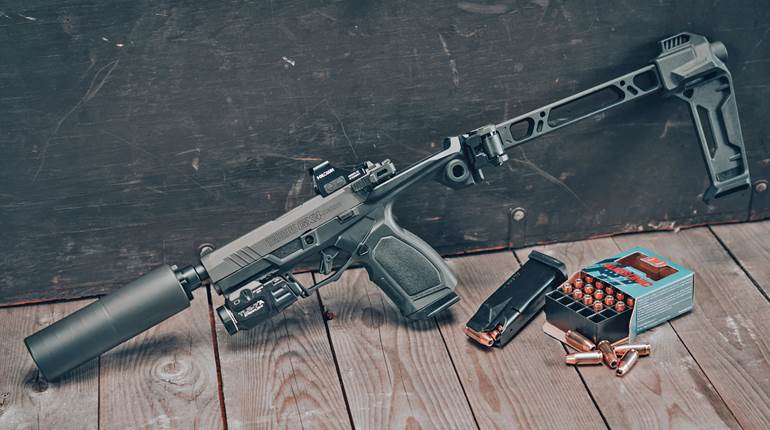
This photograph was taken after he earned the Silver Star on the first day of the battle, but before he was subsequently wounded in action and evacuated from the island. Note that he is carrying a shortened M1910 entrenching tool and a Model of 1917 fighting knife.

In the fight for Iwo Jima, one of the battles that led to the end of Imperial Japan, “uncommon valor was a common virtue.” The guns used by the Marines included John Browning designs such as the M1911A1 pistol, M1918A2 BAR and M1919A4 and M1917A1 machine guns, as well as a little-known gun called the “Stinger.”
For three years and two months, the United States had been at war with the Empire of Japan. As casualties mounted—and 1944 gave way to 1945—American forces were closing in on the home islands, and a war-weary homefront needed some inspiration. That inspiration was about to be found on an island in the Ogasawara Archipelago.
More than any other battle in the Pacific during World War II, the battle that was about to unfold on Iwo Jima would give the nation a renewed spirit of solemn optimism. It would also give our nation a new list of heroes. Like Guadalcanal, Tarawa and the other Pacific battles that came before it, Iwo Jima would create legends—legends who struggled across the island’s black sands with equally legendary firearms.
The guns of Iwo Jima were designed by Americans with names like Thompson, Garand and Browning. They were made by famous American manufacturers, including Winchester, Remington, Savage and Springfield, and they provided the firepower that the soldiers, sailors, airmen, Marines and Coast Guardsmen used to produce an incredible, albeit costly, victory.
It all began at 9 a.m. on Monday, Feb. 19, 1945, when the men of the V Amphibious Corps landed with two divisions on Iwo Jima’s southeast coast. The 4th Marine Division came ashore on the right and the 5th Marine Division came ashore on the left, just below the island’s most conspicuous terrain feature, Mount Suribachi. Within minutes, 6,000 Marines were on the beach.
At first, the lead battalions encountered only negligible opposition, but then as they began crossing the black sand terrace beyond the water’s edge, the enemy opened fire. With more than 21,000 Japanese soldiers and sailors on the island, and more than 600 bunkers, blockhouses and fighting positions, Iwo Jima was a dangerous objective, and despite three days of preliminary naval bombardment, its defenders were ready to fight:
“The enemy defenses prepared on Iwo Jima were the most difficult encountered in Marine history, and the island demonstrated itself as the most thoroughly prepared for defense yet encountered in the Pacific.” —Forward Observer’s Reports. Feb. 26 and 28, 1945

Shortly after 10 a.m., the men of the 1st Battalion, 27th Marines, ran up against an especially tough bunker complex just inland of Red Beach 2. With armor support still stuck on the beach and a pressing need to maintain the regiment’s momentum, the only way to neutralize the complex was with explosives, but there was a problem.
The fighting positions were producing such a volume of machine gun fire that the demolitions men could not get close enough to them. Without being ordered to do so, Sgt. Rinaldo Martini, a machine gun section leader in C Company, took the initiative and carefully worked his way forward to a shell hole right in front of one of the bunkers. He then stood up and began firing an M1919A4 .30-cal. machine gun from the hip.
The fire pinned down the occupants of the bunker and made it possible for a demolitions man to work his way forward with explosives and destroy it. Sergeant Martini subsequently received the Silver Star for what he did to neutralize that bunker on the morning of Feb. 19. Simultaneous to his Silver Star action, another C Company machine gun section leader was dealing with one of the other bunkers in the same complex.

By February 1945, 28-year-old Gy/Sgt. John Basilone was already a decorated combat veteran. Two years and four months earlier, he had been serving in D Company, 1st Battalion, 7th Marines, and he was in charge of two sections of M1917A1 heavy machine guns during the Battle of Henderson Field on Guadalcanal.
He spent the entire night on Oct. 24, 1942, moving from position to position keeping the guns in his section running. He personally repaired one gun and then manned it through multiple enemy attacks, and when ammunition began to run low, he moved through hostile lines to retrieve more. Basilone’s actions that night were of such an extraordinary quality that he was ultimately awarded the Medal of Honor.
Eight-hundred-and-forty-eight days later, John Basilone, the Medal of Honor recipient, was working his way around the flank of a bunker just south of Airfield No. 1 on Iwo Jima. Eventually, he fought his way to a position directly on top of that bunker and then single-handedly knocked it out using grenades and demolitions charges.
Although he would ultimately be awarded the Navy Cross for this action, he would never to be able to wear it, like he had worn the Medal of Honor. Later that day, fragments from a Japanese mortar round killed John Basilone while he was trying to assist a Sherman tank trapped in a minefield. He had spent the entire day on Feb. 19 in the forefront of the assault, and, in the end, sacrificed his life trying to help other Marines.
Just a half-mile to the left of where Martini and Basilone came ashore on Feb. 19, a Marine named Tony Stein struggled under largely similar circumstances. But Stein did not fight with an M1919A4 machine gun, he fought with one of the more obscure firearms in the U.S. military’s arsenal: the ANM2 .30-cal. machine gun—also known as the “Stinger.”
For the most part, the ANM2 presents the physical appearance of a downsized M1919 .30-cal. machine gun, because its receiver, barrel and barrel shroud are slightly smaller. This brings the ANM2’s weight down to a mere 23 lbs.—as opposed to the 31 lbs. of the M1919A4—but the similarities end there.
In addition to having a different receiver and barrel than the M1919, the ANM2 has a backplate that is equipped with spade grips, and it has a different feed cover, extractor, barrel extension and bolt. These parts were specially engineered to allow the gun to feed from either the left or right side of the receiver, a feature that made it versatile for use in aircraft.
It also produced a dramatically higher cyclic rate of fire of more than 1,300 rounds per minute. In U.S. military service, ANM2 machine guns were used by the Navy, the Army Air Forces, the Coast Guard and the various Air Groups of the Marine Corps.
Marine use of the ANM2 .30-cal. included the flexible single and twin mounts on USMC SBD Dauntless dive-bombers. But the Marine Corps use of the .30-cal. ANM2 was not limited to aerial gunnery alone.

During the Guadalcanal campaign, machine gunners had found the M1919A4 to be cumbersome and awkward when on patrol. The Marines, therefore, wanted a lightweight machine gun that could be operated by an individual and was also capable of delivering a higher rate of fire.
During the Bougainville campaign, Marines from the 3rd Parachute Battalion assembled an extensively field-modified .30-cal. ANM2 using an M1 Garand buttstock, a BAR bipod, a BAR rear sight and an improvised trigger. Although the Stinger that they assembled on Bougainville was not used in combat there, it was a successful modification that would ultimately see battle just over a year later.
In late-1943, the 3rd Parachute Battalion was disbanded, and the Marine paratroopers who had been in it were reassigned to regiments in the Fleet Marine Force. Several of them went to the 28th Marines, and, as the regiment prepared for Iwo Jima, the Bougainville veterans in its ranks recognized that the Stinger might just be a useful battle implement in the upcoming campaign.
Six ANM2s were, therefore, converted to the Stinger configuration, and six reliable machine gunners were chosen to carry the modified arms ashore during the forthcoming assault: five in G Company and a sixth man from A Company. That man was Tony Stein.

When he landed near the base of Mount Suribachi on Feb. 19, Cpl. Stein provided covering fire with his Stinger as the rest of the Marines of his platoon moved into position to attack a bunker complex. He then exposed himself to Japanese machine gun fire repeatedly, forcing the enemy to reveal their positions.
After doing so, Stein personally eliminated several fighting positions, killing at least 20 defenders in the process. During this time, his Stinger was shot out of his hands twice. Because of the gun’s voracious appetite for ammunition, Stein was forced to return to the beach eight times to retrieve additional belted ammunition.
During the trips to the rear, Stein was seen carrying wounded Marines to safety. On a day that was characterized by acts of bravery, Cpl. Tony Stein’s actions stood out as especially remarkable. From the start, he was conspicuously present at the front of the attack as the 28th Marines pushed all the way across the narrowest part of the island, cutting off Mount Suribachi in so doing.
By the end of D+1, the Marines had overrun Airfield No. 1 and five out of the six regiments on the island at that point turned north and began the drive toward Airfield No. 2. The sixth regiment—the 28th Marines—turned in the opposite direction so that it could deal with the 554-ft- tall dormant volcanic cone to the south.
On the morning of Feb. 23, a 40-man combat patrol from E Company, 2nd Battalion, 28th Marines, was sent up Suribachi’s northeastern slope. They encountered only light resistance on the way up, and at 10:15 a.m. they reached the summit.
Fifteen minutes later, they raised an American flag using a discarded water pipe for a pole. There was a problem though—the flag was not quite large enough to be seen by the men struggling on the sandstone plateau below Suribachi, so a runner was sent to the beach to find a larger one.
When the runner returned to the summit around noon, he was carrying a larger flag that came from a Landing Ship Tank (LST). Shortly thereafter, the first flag came down, the second flag went up, and several photographers captured it all on film.
Still and moving pictures of the first and second flag-raisings reveal fascinating details about how a typical Marine infantry platoon was armed during the battle of Iwo Jima. While the M1 carbine was present on the summit, the M1 rifle was there in greater numbers.
By this point in the Pacific war, the smallest maneuver unit on the battlefield for the Marine Corps was the “fire team,” which was built around an automatic rifle and three riflemen. A 13-man rifle squad was therefore made up of three fire teams, giving each rifle platoon the power of nine automatic rifles, and each company the power of 27.
The gun that gave USMC fire teams so much muscle was the M1918A2 Browning Automatic Rifle. That variant introduced a skid-footed adjustable bipod mounted at the muzzle on the flash hider and fire-control components that differed from the World War I-era BAR that the Marine Corps fought with earlier in the conflict.
That model allowed the shooter to select between semi-automatic and full-automatic fire, but the new M1918A2 provided full-automatic fire only in either a fast mode at 650 r.p.m. or a slow mode of 400 r.p.m., thanks to a rate reducer in the buttstock assembly. In 1942, a carrying handle became part of the design, but in the field the Marines tended to discard that item, in addition to the bipod.

The emphasis on the fire team in the new table of organization greatly enhanced the firepower capability of USMC ground units, and it was in full force by the time of the landings on Iwo Jima in early 1945. This is why, in terms of firepower, the Marine units fighting on the island look quite a bit different than the Marine units that fought the Guadalcanal campaign.
By February 1945, the M1 Garand and the M1 carbine had replaced the M1903 rifle and the Reising submachine gun. In fact, the submachine gun was being issued less and less in the Fleet Marine Force at that late stage of the war.
The Reising was by then long gone and, while only a few are to be observed on Iwo, the .45 ACP Thompson submachine gun was there in both the M1928A1 and M1A1 versions. Archival photography from the battle reveals an abundance of M1 carbines, and the majority of the examples on the island during the fighting were equipped with the M8 grenade launcher.
In addition to the BAR and the ANM2 Stinger, four other significant Browning-designed firearms were a part of the fight for Iwo Jima: the M2HB .50-cal. heavy machine gun; the M1919A4 light machine gun; the M1917A1 heavy machine gun; and the M1911A1 pistol.
The M2HB armed the Landing Vehicle, Tracked (LVTs) that brought the troops from ship to shore as did the M1919A4, which can also be seen on Higgins boats operated by both the Navy and the Coast Guard. The M1919A4 also fought ashore, and several archival photographs reveal that the Marines customized many of them with a camouflage paint pattern.
The M1917A1 water-cooled machine gun was also an important asset for ground combat on the island despite the fact that it was not capable of advancing with an attacking echelon. Nevertheless, the M1917A1 was ideal for defensive positions and sustained suppressive fire at long ranges.
The photographic evidence even shows that the Marines camouflaged their M1917A1s as well, in addition to personalizing them with “nose art” in some cases. Although for the most part combat on Iwo Jima took place using heavier weapons, the .45 pistol was present in large numbers as the ultra-reliable sidearm that every man could always depend on. It can be seen arming officers, NCOs and special troops, such as flamethrower operators.
Still another firearm that John Browning inspired—but designed by T.C. Johnson—was carried ashore by the Marines during the battle: the Winchester Model 12 “trench” gun. In one well-known photograph taken on the plateau just south of Airfield No. 1, a Marine can be clearly seen carrying a Model 12.
While John Browning’s legacy was well-represented on the island, so too was the legacy of Isaac Newton Lewis. At least one example of his air-cooled light machine gun design fought for the Japanese on the ground during the battle, and we know this because an Imperial Navy Type 92 light machine gun in 7.7x56 mm R (.303) appears in a photograph showing a collection point for small arms picked up from the battlefield.
While it could be used in the tailgunner position of an Imperial Navy dive-bomber or torpedo plane, the Type 92 was also used by naval infantry with a full-wood buttstock, which is the version that can be seen in the photograph described above.
Still another Japanese aircraft machine gun that was put to use during ground combat on Iwo Jima was the Japanese Type 98 in 7.92x57 mm Mauser. Designed in Germany by Theodor Bergmann as the MG.15, the Type 98 is recoil-operated, feeds from a 75-round, top-mounted double-drum magazine and fires at the high cyclic rate of just over 1,000 r.p.m.
But aircraft guns being used for ground combat were uncommon. The Japanese army and navy both made widespread use of two very effective automatic arms throughout the battle: the Type 92 heavy machine gun and the Type 99 light machine gun, both in the potent 7.7x58 mm Japanese cartridge.
Those two guns provided the bulk of the machine gun firepower of Imperial forces during the battle and, together with effective artillery and mortar fire, made the Americans suffer for every square inch of terrain:
“Coordination in the Japanese use of artillery and mortar fire was demonstrated on Iwo to a greater extent than has previously been experienced.” —Forward Observer’s Reports. Feb. 26 and 28, 1945
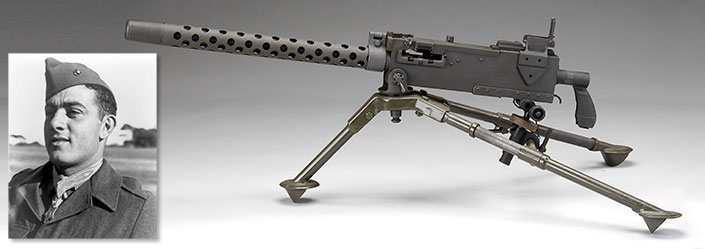
The day after the flag-raising (Feb. 24), the total number of Americans on the island reached 70,000 as three Marine Divisions pushed north into heavily defended terrain. With every yard gained, Japanese opposition intensified and casualties mounted.
It had been estimated that five days of fighting would be required to secure Iwo Jima, but after five days came and went, it was obvious that the V Amphibious Corps was in for a much tougher fight. That was due in part to the island’s formidable terrain, but also due to Japanese combat effectiveness.
The island’s garrison was not engaging in wasteful, large-scale night attacks the way that other garrisons had in previous Pacific battles. Instead, Gen. Tadamichi Kuribayashi had infiltration teams probe American lines after dark when supporting fire was less effective.
This not only allowed Kuribayashi to conserve his force to the greatest extent possible, it also imposed unexpectedly high combat attrition on the Americans. By the sixth day of the battle (Feb. 25), casualties in the V Amphibious Corps had reached 5,500 wounded and 1,600 killed in action.
At places with names like the Amphitheater, Turkey Knob, Hill 382 and Cushman’s Pocket, the cost in lives continued rising as February drew to an end. On March 1, A Company, 28th Marines went up against a particularly tough objective: Hill 362A just north of Airfield No. 2.
During the attack, Tony Stein volunteered to lead some of the men from the company in locating and destroying a complex of Japanese bunkers just like he had done on the first day of the battle. While firing his Stinger at one position, the fire from an unseen position cut him down.
On Feb. 19, 1946, the first anniversary of the amphibious assault on Iwo Jima, Stein was posthumously awarded the Medal of Honor in recognition for the unhesitating bravery he exhibited on Feb. 19, 1945, and during the 10 days that followed.
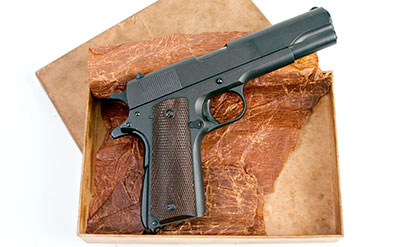
On March 8, one element of the Japanese garrison departed from Gen. Kuribayashi’s preferred strategy of static defense. In the pre-dawn darkness, the Naval Guard Force commander on the island led a 1,000-man bayonet charge in a futile attempt to retake Mount Suribachi.
The attack fell on the lines of the 4th Marine Division and failed with the largest loss of Japanese life in a single action during the battle. When patrols of the 3rd Marine Division reached Iwo Jima’s north coast the following day, Kuribayashi’s command had been severed in two.
Although the battle now entered its final phase, the attritional slogging match nevertheless inched-forward with artillery and tank support until the island was declared secure at 6 p.m. on Friday, March 16.
That announcement turned out to be premature though because the 5th Marine Division had to continue fighting against a pocket of resistance in a gorge at Kitano Point in the island’s northern sector. General Kuribayashi maintained his command post in a cave in that gorge until the Marines destroyed it with four tons of explosives on March 21.
Three days later, they sealed all of the remaining cave entrances at the point, and yet the battle was still not quite over. Before sunrise on Sunday, March 25, a 300-man banzai attack crashed into Marine and U.S. Army support units in the vicinity of Airfield No. 2.
Side-by-side, Marines, soldiers and sailors fought back against the Japanese effort until the dawn revealed more than 200 enemy dead scattered about the bivouac area. It was the final counterattack of the Iwo Jima campaign. At 9 a.m. the following morning, March 26, the island was declared secure once and for all.

The cost was great for both sides. More than 6,800 Americans lost their lives and, for the Japanese, the total lost was more than 18,000. The 36-day-long battle was fought in the air, at sea and on land.
For the men who struggled across the island’s black sand beaches, its central plateau and the deep gorges of its northern sector, the terrain had been a great equalizer that reduced the combat to close ranges—the kind of close ranges where individual firepower mattered.
Rinaldo Martini, John Basilone and Tony Stein experienced the up-close-and-personal qualities of that battle, but only Martini survived it. Although he lived to see old age, he did so with only one arm as the other one was lost on Iwo Jima. He passed away in 2003 at the age of 83, and is buried in Riverside National Cemetery in California.
Basilone and Stein were buried on Iwo Jima alongside thousands of other men who made the supreme sacrifice on the island. They remained there until 1949 when all American graves were exhumed and repatriated. Stein is buried today in Dayton, Ohio, and Basilone in Arlington National Cemetery.
They remind us that the generation that fought the battle of Iwo Jima passionately believed in their cause and their comrades. They remind us not to give in to the cynicism and disenchantment that surround our everyday lives.
In bringing honor on themselves through acts of sacrifice and valor that continue inspire us even after 75 years, they give us something to be proud of. Like so many others, they gave everything on that island and all we have to do is remember them.










